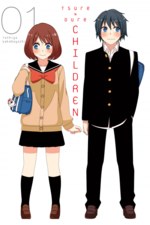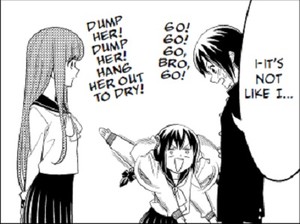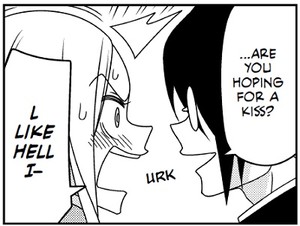The Spring 2017 Manga Guide
Tsuredure Children Vol. 1
What's It About?
 Tsuredure Children is a 4-koma manga by Toshiya Wakabayashi. The series is a collection of comedic short stories about the difficulties high school students have trying to confess their love for one another. The manga focuses on a wide cast of students attending the same school.
Tsuredure Children is a 4-koma manga by Toshiya Wakabayashi. The series is a collection of comedic short stories about the difficulties high school students have trying to confess their love for one another. The manga focuses on a wide cast of students attending the same school.
Tsuredure Children volume 1 (4/4/2017) is available for $10.99 from Kodansha USA. An anime based on the series is set to debut in July 2017.
Is It Worth Reading?
 Nik Freeman
Nik Freeman
Rating: 4
Tsuredure Children might be the best of the handful of 4-koma manga I've read. Chapters range from cute and heart-warming to painfully awkward to straight-up slapstick, and while not every miniature story is great, many are amazing. Wakabayashi finds so many different ways to use such a simple and relatable premise, starting off with two characters too shy to confess to each other and eventually escalating to one girl putting a marriage registration form in her Valentine's chocolate, another getting swung through the air by the mask she's disguising herself from her crush with, and a third climbing a tree and meowing like a cat so her crush will come to her rescue. I swear that in context it all makes sense…of a sort.
Most of Tsuredure Children's chapters work off a basic truth: misunderstandings can occur if people don't communicate clearly. Sometimes this leads to a pretty predictable outcome – one character tries to confess to another, can't quite get the words out, says something that can be misinterpreted, isn't able to correct their crush's misinterpretation, awkwardness ensues. The token teacher-student relationship plays things completely by the book in this regard. But Tsuredure Children plays with the concept of misunderstandings a lot, such as with Keisuke, who can't figure out if foreign exchange student Patricia is trying to confess to him or not because her Japanese is so bad. Then there's Kana, who can't figure out why she and her boyfriend/sketch comedy partner Chiaki haven't made any progress in their love life (the reveal is hilarious, no spoilers). Even when not directly involved with anyone romantically, some of the characters are absolutely hilarious. When clingy little sister Hotaru finds out a girl is openly attracted to her brother, who is pretty obvious about returning the feelings, she has an incredible string of facial reactions, each one funnier than the last. Then there's helpful senpai Katori, who steals the scene in every panel he appears in. Katori is so ridiculously cheesy and lame that he somehow laps around to being smooth and cool, even when he's getting dropkicked in the face.
Tsuredure Children is adorable and hilarious. At its absolute worst, it's standard for a series that focuses on the cuteness and awkwardness of young love. At its best, it's side-splittingly funny, charming, and even occasionally really heart-warming. There's no ongoing plot and thus no real drama to be found, but it's perfect for a quick read to put a smile on your face if you find any joy or amusement in the innocence of young romance.
 Rebecca Silverman
Rebecca Silverman
Rating: 4
If you're looking for a lot of plot, this isn't the book for you. That's not to say that there isn't one – the characters we meet in each mini-chapter do recur at times, although it can be hard to tell them all apart if they don't have distinguishing features like a specific hairstyle or glasses. But each chapter essentially tells a complete story in about eight four-panel comics, with the major unifying feature being “awkward high school love.”
Despite their brevity, each story is actually funny, with some stories getting more mileage out of their premises than others. For example, the pieces about the astronomy club aren't particularly great, as there's only so much that can be done with the theme of “girl loves graduating/graduated senpai,” but the stories featuring exchange student Patricia and her mysterious use of the word “sushi” are consistently good. Does she mean “suki (like)?” Does she mean the food? Something else entirely? The poor boy she keeps talking to will never know as he desperately tries to figure out if she's got a crush on him or not and how he should be responding. Likewise, the case of the girl who opens her story with, “We've been dating for a year now” only to find out that the guy was completely unaware of it is also great. Really the best pieces in here are the ones that emphasize the awkwardness of being in high school and having a crush on someone and having exactly no idea what to do with yourself or with them. Even if it isn't specifically relatable to you, it's pretty darn funny.
The artwork is very simple, as befits a four-koma series, but as I said before, it can be hard to tell the characters apart. There's a lot done with facial expressions, mostly the fade to a shocked or horrified face to end a strip, and when it needs to be there, movement is well done. All in all this is just a fun, silly book that's easily read in bits and pieces when you just need a chuckle. Lighthearted and charming, it's a nice pick-me-up when you need it.
 Amy McNulty
Amy McNulty
Rating: 2.5
At the start of Tsuredure Children, it doesn't even seem like the confessions will prove related or that characters will appear again once their turn in the spotlight is over, so often does it move from one couple to the next. Eventually, most do come back at one point or another since all of the students attend the same school and rarely are the confessions resolved after one story. Unfortunately, the sheer number of characters makes it difficult to keep track of them from one appearance to the next—particularly some of the boys, who resemble each other. With love triangles and squares at work, it's not unforgivable to accidentally think one boy has more girls after him than he actually does before realizing he's a different character entirely or to forget that another boy has already been confessed to by one girl when another girl starts showing interest in him. There are a few character designs and personalities that stand out—Takao Yamane, the odd-faced boy afraid of being mistaken for a pervert in particular—but for the most part, the boys are easier to forget than the girls and only some of the girls prove memorable from one story to the next. (Usually in less-than-admirable ways, like Alice Himemiya, the girl who puts blood in her Valentine's chocolate and sabotages her rival's attempts at confessing to their shared object of affection.) Because the reader can't always keep the characters straight and doesn't spend enough time with any one character to grow to care about them, the end result is rather flat, even if the concept is fun enough to encourage the reader to keep flipping the pages.
The stories are all supposed to be steeped more in humor than emotion, but many of the jokes disappoint. Still, almost none are offensive and perversion is actually perhaps surprisingly not one of the recurring themes. Despite the four-panel format, Wakabayashi doesn't overload each strip with a joke, instead making all of the strips in a story blend together for comedy throughout, which helps keep the pacing manageable but also makes the need to rely on a four-panel format unclear. The only couple that proves especially irksome to an English-speaking audience (whereas it might not to the original Japanese audience) is exchange student Patricia Caulfield and Keisuke Tsuji, whose entire bit revolves around a miscommunication due to Patricia's poor grasp of Japanese. Unfortunately, it asks the reader to believe an English speaker spending a year or more in Japan doesn't know what sushi is and could possibly mix up that word with “suki,” (to like/love), one of the most basic words in the Japanese language.
Wakabayashi's art, while satisfactory, does have that character design overlap working against it, and the four-panel format means the art is minimal and almost entirely devoid of background details. Tsuredure Children is a fast, pleasant enough read, but its art underwhelms and its characters won't stick with the reader for long.
discuss this in the forum (49 posts) |
this article has been modified since it was originally posted; see change history
back to The Spring 2017 Manga Guide
Feature homepage / archives